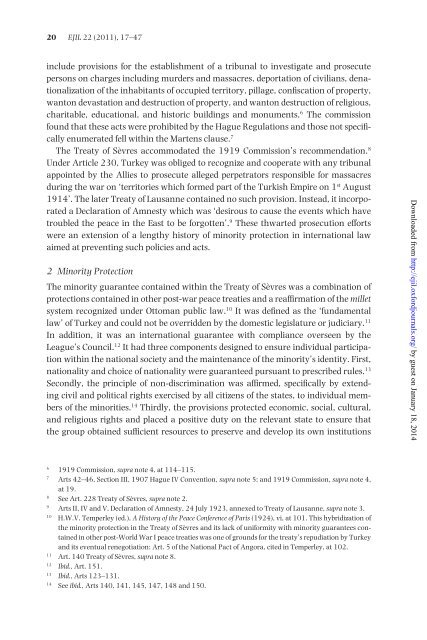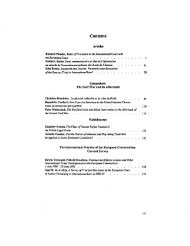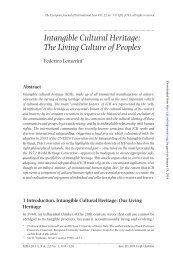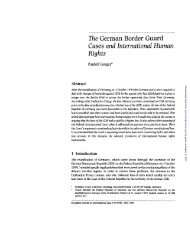Genocide and Restitution - European Journal of International Law
Genocide and Restitution - European Journal of International Law
Genocide and Restitution - European Journal of International Law
Create successful ePaper yourself
Turn your PDF publications into a flip-book with our unique Google optimized e-Paper software.
20 EJIL 22 (2011), 17–47<br />
include provisions for the establishment <strong>of</strong> a tribunal to investigate <strong>and</strong> prosecute<br />
persons on charges including murders <strong>and</strong> massacres, deportation <strong>of</strong> civilians, denationalization<br />
<strong>of</strong> the inhabitants <strong>of</strong> occupied territory, pillage, confiscation <strong>of</strong> property,<br />
wanton devastation <strong>and</strong> destruction <strong>of</strong> property, <strong>and</strong> wanton destruction <strong>of</strong> religious,<br />
charitable, educational, <strong>and</strong> historic buildings <strong>and</strong> monuments. 6 The commission<br />
found that these acts were prohibited by the Hague Regulations <strong>and</strong> those not specifically<br />
enumerated fell within the Martens clause. 7<br />
The Treaty <strong>of</strong> Sèvres accommodated the 1919 Commission’s recommendation. 8<br />
Under Article 230, Turkey was obliged to recognize <strong>and</strong> cooperate with any tribunal<br />
appointed by the Allies to prosecute alleged perpetrators responsible for massacres<br />
during the war on ‘territories which formed part <strong>of</strong> the Turkish Empire on 1 st August<br />
1914’. The later Treaty <strong>of</strong> Lausanne contained no such provision. Instead, it incorporated<br />
a Declaration <strong>of</strong> Amnesty which was ‘desirous to cause the events which have<br />
troubled the peace in the East to be forgotten’. 9 These thwarted prosecution efforts<br />
were an extension <strong>of</strong> a lengthy history <strong>of</strong> minority protection in international law<br />
aimed at preventing such policies <strong>and</strong> acts.<br />
2 Minority Protection<br />
The minority guarantee contained within the Treaty <strong>of</strong> Sèvres was a combination <strong>of</strong><br />
protections contained in other post-war peace treaties <strong>and</strong> a reaffirmation <strong>of</strong> the millet<br />
system recognized under Ottoman public law. 10 It was defined as the ‘fundamental<br />
law’ <strong>of</strong> Turkey <strong>and</strong> could not be overridden by the domestic legislature or judiciary. 11<br />
In addition, it was an international guarantee with compliance overseen by the<br />
League’s Council. 12 It had three components designed to ensure individual participation<br />
within the national society <strong>and</strong> the maintenance <strong>of</strong> the minority’s identity. First,<br />
nationality <strong>and</strong> choice <strong>of</strong> nationality were guaranteed pursuant to prescribed rules. 13<br />
Secondly, the principle <strong>of</strong> non-discrimination was affirmed, specifically by extending<br />
civil <strong>and</strong> political rights exercised by all citizens <strong>of</strong> the states, to individual members<br />
<strong>of</strong> the minorities. 14 Thirdly, the provisions protected economic, social, cultural,<br />
<strong>and</strong> religious rights <strong>and</strong> placed a positive duty on the relevant state to ensure that<br />
the group obtained sufficient resources to preserve <strong>and</strong> develop its own institutions<br />
Downloaded from http://ejil.oxfordjournals.org/ by guest on January 18, 2014<br />
6<br />
1919 Commission, supra note 4, at 114–115.<br />
7<br />
Arts 42–46, Section III, 1907 Hague IV Convention, supra note 5; <strong>and</strong> 1919 Commission, supra note 4,<br />
at 19.<br />
8<br />
See Art. 228 Treaty <strong>of</strong> Sèvres, supra note 2.<br />
9<br />
Arts II, IV <strong>and</strong> V, Declaration <strong>of</strong> Amnesty, 24 July 1923, annexed to Treaty <strong>of</strong> Lausanne, supra note 3.<br />
10<br />
H.W.V. Temperley (ed.), A History <strong>of</strong> the Peace Conference <strong>of</strong> Paris (1924), vi, at 101. This hybridization <strong>of</strong><br />
the minority protection in the Treaty <strong>of</strong> Sèvres <strong>and</strong> its lack <strong>of</strong> uniformity with minority guarantees contained<br />
in other post-World War I peace treaties was one <strong>of</strong> grounds for the treaty’s repudiation by Turkey<br />
<strong>and</strong> its eventual renegotiation: Art. 5 <strong>of</strong> the National Pact <strong>of</strong> Angora, cited in Temperley, at 102.<br />
11<br />
Art. 140 Treaty <strong>of</strong> Sèvres, supra note 8.<br />
12<br />
Ibid., Art. 151.<br />
13<br />
Ibid., Arts 123–131.<br />
14<br />
See ibid., Arts 140, 141, 145, 147, 148 <strong>and</strong> 150.








